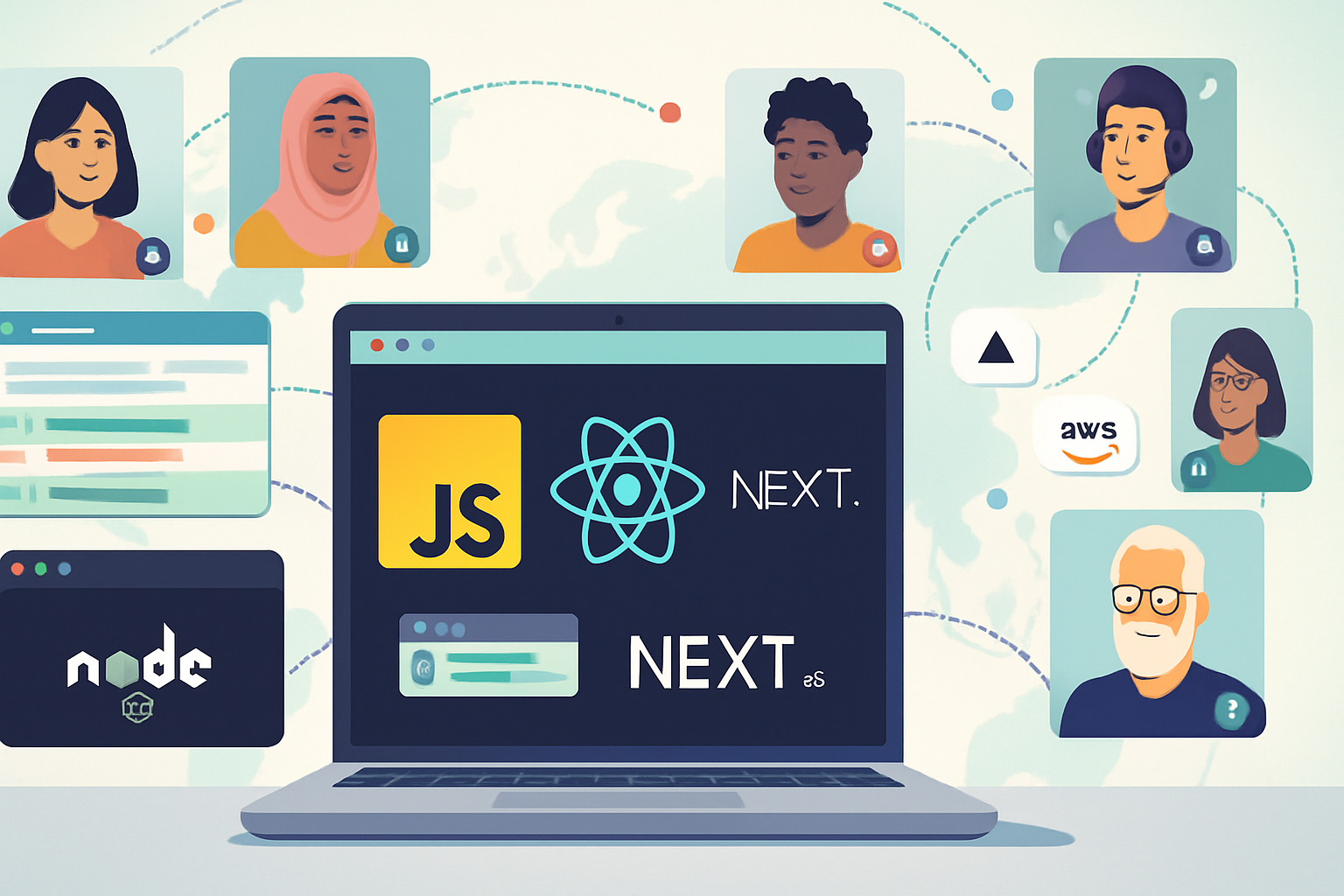· career · 6 min read
Navigating the Remote JavaScript Job Market: Top Companies Hiring in 2023
A practical guide to the remote JavaScript job market in 2023 - which companies were hiring, which skills were most in demand, what employers look for, and tactical tips to stand out in the application and interview process.

Why this guide (and why 2023 matters)
Remote work became a standard practice after 2020, and by 2023 many leading tech companies had established stable remote or distributed hiring models. For JavaScript developers this meant more opportunities across front-end, full-stack, and server-side roles - but it also raised the bar: companies expected deep technical skills plus remote collaboration competencies.
This post walks through notable employers that hired remote JavaScript talent in 2023, the skills and technologies in demand, what hiring teams look for, and actionable tips to boost your chances.
Companies hiring remote JavaScript developers in 2023 (notable examples)
Many organizations maintained distributed teams or remote-first hiring pipelines in 2023. Not every company has the same remote policy (fully remote vs. remote-friendly vs. hybrid), so check role listings for location requirements. Examples of companies that listed remote JavaScript roles in 2023 include:
- Automattic (remote-first): https://automattic.com/work-with-us/
- GitLab (fully remote): https://about.gitlab.com/jobs/
- Vercel (frontend/platform focus, remote roles): https://vercel.com/careers
- Netlify (remote roles for web engineers): https://www.netlify.com/careers/
- HashiCorp (distributed teams): https://www.hashicorp.com/careers
- Stripe (payments platform hiring engineers globally): https://stripe.com/jobs
- Coinbase (crypto exchange, remote positions): https://jobs.coinbase.com/
- Atlassian (remote- and hybrid-friendly roles): https://www.atlassian.com/company/careers
- Elastic (distributed and hybrid roles): https://www.elastic.co/about/careers
- Zapier, Buffer, Basecamp (smaller fully distributed companies): https://zapier.com/jobs/, https://buffer.com/journey, https://basecamp.com/about
For market-wide data that reinforces JavaScript’s continued dominance, see the Stack Overflow Developer Survey 2023: https://survey.stackoverflow.co/2023/ - JavaScript remains the most commonly used language among developers.
High-demand skills and technologies in 2023
Recruiters and hiring managers in 2023 repeatedly looked for these skills. If you’re job hunting, prioritize learning and demonstrating these areas:
Core language & tooling
- JavaScript (ES6+) fundamentals: closures, async/await, event loop, prototypal inheritance.
- TypeScript - widely requested for larger codebases.
- Node.js - server-side JavaScript for full-stack roles.
- Package & build tools: npm/yarn, Webpack, Vite, esbuild.
Front-end frameworks & meta-frameworks
- React and its ecosystem (Hooks, Context, Suspense). Popular roles often expect deep React knowledge.
- Next.js (server-side rendering, static generation) - heavily used by companies focused on web performance.
- Vue and Svelte appear in many companies’ stacks, but React/Next.js dominated listings in 2023.
API & data
- REST & GraphQL (Apollo, Relay) for client-server communication.
- Familiarity with WebSockets and real-time patterns.
Architecture, performance & quality
- Web performance optimization (Lighthouse, Core Web Vitals).
- Testing: Jest, Testing Library, Cypress for end-to-end tests.
- Accessibility (a11y) - increasingly a hiring requirement.
- State management: Redux, Zustand, Recoil, or modern patterns.
DevOps & cloud integration
- CI/CD pipelines (GitHub Actions, GitLab CI, CircleCI).
- Serverless platforms (AWS Lambda, Vercel Functions) and basic cloud skills (AWS/GCP/Azure).
- Docker and containerization for reproducible dev environments.
Collaboration & remote work tools
- Git + solid pull-request workflow.
- Async comms and collaboration: Slack, Notion, Figma (for design handoffs), Zoom.
Soft skills
- Clear written communication, async collaboration, ownership and product sense.
What top employers look for (beyond keywords)
Most hiring teams use a combination of technical screening and behavioral evaluation. Here’s how to think like a hiring manager:
Technical depth and fundamentals
Employers want to know you truly understand JavaScript and how the web works - not just that you’ve used a framework. Expect questions about the event loop, memory leaks, performance bottlenecks, and debugging.
Code quality and maintainability
Clean, testable, well-documented code signals professional readiness. TypeScript + tests are often expected on production teams.
Product and UX awareness
Strong candidates demonstrate product sense: shipping the smallest useful feature, measuring impact, and considering accessibility and performance.
Remote collaboration & asynchronous communication
Can you write clear issue descriptions, give concise PR reviews, and keep stakeholders informed without daily in-person meetings?
Ownership and delivery
Hiring managers want engineers who can take features from proposal to production: design decisions, tradeoffs, and follow-through.
Learning velocity and growth mindset
Tech stacks evolve fast. Employers prefer adaptable engineers who can learn patterns and mentor others.
How to tailor your applications (concrete checklist)
- Have a concise, role-specific resume. Lead with relevant JavaScript/TypeScript experience and production projects.
- Public code: maintain a GitHub profile with well-crafted repos - include READMEs, tests, and deployment links.
- Deploy a portfolio or demo site (Netlify/Vercel) so recruiters can interact with your work.
- Contribute to open source (even small bug fixes) - it demonstrates collaboration and real-world code experience.
- Include a short customized cover letter or application note that references the company’s product and explains how you’d add value.
- Prepare a few behavioral stories (STAR format) that show ownership, collaboration, and conflict resolution.
Interview preparation: what to expect and how to prepare
Interview formats vary, but common elements for remote JavaScript roles include:
- Phone / screening: high-level questions and culture fit.
- Technical screen: live coding (shared editor or pair-programming) or take-home assignment.
- Onsite / loop: multiple interviews (system design, debugging, front-end challenge, behavioral rounds).
Practical prep tips
- Practice coding in editors commonly used in interviews (CoderPad, VS Code Live Share). Focus on writing clear, testable code and explaining your reasoning.
- Rehearse front-end specific topics: DOM manipulation, reflows/repaints, event delegation, accessibility, and optimizing page load.
- Build or polish a small demo that showcases state management, API usage, performance optimizations, and tests - use it as a talking point during interviews.
- If given a take-home, deliver a clean, documented project; follow the instructions and scope precisely - hiring teams often value shipping a constrained, polished solution over an incomplete overambitious one.
Sample interview question topics
- Implement a debounced search input in React and explain tradeoffs.
- Optimize a React app with performance bottlenecks (explain memoization, code-splitting).
- Design a simple real-time chat API (WebSockets vs. polling).
- Explain memory leaks in a browser and how you’d detect/fix them.
Negotiation & compensation (remote considerations)
Remote roles may be paid based on location, global bands, or fully location-agnostic. Before negotiating:
- Research comparable salaries for your level and region (resources like Glassdoor, Levels.fyi can help but verify current data yourself).
- Ask about base salary, stock/equity, benefits, and any stipend for home office equipment.
- If a role is remote but requires specific time-zone overlap, factor that into expectations and compensation discussions.
Small roadmap to get hired (3-month plan)
Month 1 - Foundations
- Solidify JavaScript fundamentals and TypeScript basics.
- Build a simple full-stack app (React + Node or Next.js) and deploy it.
- Clean up GitHub and resume.
Month 2 - Deepen & Showcase
- Add tests, optimize performance, and improve accessibility for your project.
- Write 2–3 short blog posts or README case studies explaining architecture decisions.
- Start applying to targeted roles (customize applications).
Month 3 - Interview focus
- Do focused interview practice (system design for front-end, debugging exercises, pair-programming mock interviews).
- Polish behavioral stories and your pitch.
- Continue applying and network with engineers at target companies.
Final thoughts
The remote JavaScript job market in 2023 offered abundant opportunities but also increased expectations: companies wanted engineers who combine strong technical skill with the discipline and communication practices required for distributed teams. Focus on demonstrable projects, clear async communication, and domain-specific skills (TypeScript, React/Next.js, testing, performance). That combination will make you stand out whether you’re applying to a startup or an established distributed company.
Further reading
- Stack Overflow Developer Survey 2023: https://survey.stackoverflow.co/2023/
- GitLab job listings and remote resources: https://about.gitlab.com/jobs/



